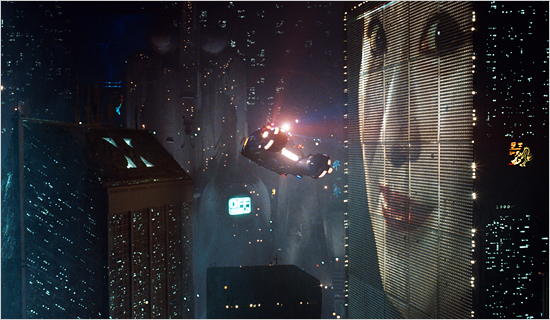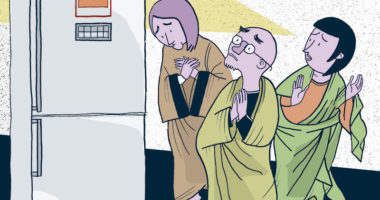
Blade Runner (1982).
Mientras por estos días en Barcelona se desarrolla la Smart City Expo, cabe hacernos algunas preguntas respecto a cómo se prefiguran esas ciudades inteligentes y de qué modo, en su seno, serán afectadas las instituciones culturales y el ejercicio ciudadano. Nuevas oportunidades y desafíos.
De repente una de las obras clásicas de las artes mediales se convierte en una metáfora oportuna. En La ciudad legible (Legible city, 1989), de Jeffrey Shaw, el visitante puede montar una bicicleta estática y navegar las calles de una ciudad de palabras, una simulación 3D que se construye de sentidos. Una ciudad de datos. Veintitrés años después, la esencia de la tan mentada «Smart city» tiene bastante que ver con el escenario de Shaw.
Para empezar, en las metrópolis contemporáneas asistimos a un cambio que por obvio no deja de ser fundamental. La información ya no habrá que ir a buscarla a uno de sus templos pasados ni tampoco absorberla a través de los medios de comunicación. Los datos fluyen por entramados cerrados y abiertos, así en el cielo como en la tierra. Los datos provenientes de redes de sensores, conexiones M2M ( Machine to machine), contribuidos por los usuarios a través de redes sociales y crowdsourcing bajarán desde la nube para aumentar el espacio físico urbano. Si bien el gran desafío continúa siendo cómo convertir todos esos datos en información con sentido y útil, lo cierto es que los datos y los dispositivos que los sensan y hacen circular, ya existen y están conectados.
Cada vez más empresas de diseño de experiencias de usuario se vuelcan al desarrollo de interfaces físicas o mobile apps que integran los datos con la vida urbana. Urbanscale, de Adam Greenfield es un buen ejemplo de ello con su servicio UrbanFlow para aumentar las pantallas de la ciudad (en las estaciones de transporte, las calles, etc.) con información «diseñada y situada» para que los ciudadanos encuentren lo que buscan, planifiquen recorridos, y hasta participen de la vida cívica.
Sin ir más lejos, en Barcelona, la empresa WorldSensing ha instalado sensores que recogen información sobre el tráfico para, a través de una mobile app, ayudar a los conductores a encontrar un sitio donde aparcar. En una dirección similar, el proyecto europeo iCity, liderado por la Ciudad Condal, busca abrir las infraestructuras urbanas para que agentes interesados puedan aumentarlas con datos abiertos y ofrecer servicios de interés público que mejoren la vida en la ciudad. Un parquímetro que brinda información sobre la calidad del aire en su ubicación, una app que avisa si la piscina pública o el parque ya están abarrotados de gente, una máquina expendedora de tickets de transporte que además de venderte la T10 te sugiere participar en una consulta popular.
Apocalípticos e integrados, utopía y distopía. Como siempre, las visiones sobre el futuro están marcadas por ideas fuertemente contrapuestas. Hay quienes consideran que uno de los grandes riesgos de la Smart City es el ascenso de la sociedad Orwelliana, donde la tecnología en manos de monopolios y gobiernos autoritarios sólo será aprovechada para monitorear y observar a los ciudadanos. Seguridad y privacidad continúan siendo una frontera complicada. Por otro lado, las visiones más optimistas entienden que la tecnología y los datos abren puertas hacia la transparencia, la participación ciudadana y la emancipación de sectores de la ciudadanía que estaban excluidos. También abogan por la ciudad sostenible donde es la propia comunidad la que, teniendo en cuenta los datos abiertos (open data), reduce su consumo energético o asume comportamientos más responsables. El proyecto “The tidy street”, en Brighton, es un gran ejemplo de iniciativa ciudadana para el control del consumo de electricidad.
Por eso, el meme smart city debe ir mucho más allá de las propuestas para la optimización de recursos y la eficiencia Hi-tech. Mientras corporaciones como IBM ofrecen a los ayuntamientos soluciones del tipo » smart city in a box» que implican grandes inversiones en tecnología a pesar de que no existen evidencias contundentes de que aquello que funciona en una ciudad puede ser exitosamente trasplantado a otra, las investigaciones sugieren que no habrá ciudad inteligente si no se pone al ciudadano en el centro de la ecuación.
Esta año, el Institute for the Future y la Fundación Rockefeller dieron a conocer el informe » Un planeta de laboratorios cívicos» donde se sugiere que para que las ciudades sean realmente inteligentes los datos deben servir para generar inclusión y desarrollo. No basta con las soluciones top-down, de arriba hacia abajo, propuestas por las grandes empresas tecnológicas. Según el reporte, en la ciudad actual existe una fuerza pujante y de oposición conformada por empresarios, hackers, hacktivistas y ciudadanos que persiguen una visión diferente de la urbe futura. Su terreno de juego son los datos convertidos en información para fomentar la concreción de ciudades más democráticas, más inclusivas y resilientes.
Estos urbanistas do-it-yourself (DIY) adoptan tecnologías de código abierto y estrategias de cooperación para que las innovaciones sean desde y para la ciudadanía, aumentando el compromiso social y asegurando que la hazaña tecnológica esté alineada con los intereses cívicos. En esta línea, proyectos como Smart Citizen (un kit de sensores para medir datos ambientales y conectarlos en red vía Cosm), del FabLab de Barcelona o DCDCity, incubado en el MediaLab Prado, abonan la smart city desde la acera alternativa: código abierto, filosofía hazlo tú mismo, y participación ciudadana. ¿Qué rol juegan aquí las escuelas y los centros culturales? ¿De qué manera se integran estos proyectos a la agenda cultural y la currícula educativa? ¿Cómo se educarán los smart citizens?
Es probable que, en el futuro, las ciudades exitosas deban integrar ambos modelos. Las soluciones ideales combinan las plataformas tecnológicas a gran escala con las grandes innovaciones impulsadas por los ciudadanos. Hasta cierto punto, esta integración ya está en marcha, pero las administraciones públicas necesitan darle forma en el marco de una agenda de apertura, transparencia e inclusión.
Las ciudades son como organismos vivos cuyos espíritus superan ampliamente el entramado tecnológico y la infraestructura. Son las comunidades humanas las que construyen y sostienen un ADN particular urbano, y son estas particularidades, incluso a veces caprichosas y hasta inexplicables, las que deben ser tenidas en cuenta en el diseño de innovación para la ciudad.
Cabe también imaginar qué nuevas infraestructuras redibujarán el paisaje de las ciudades posmodernas, conectadas hasta la médula, digiriendo en tiempo real las informaciones que la habitan, desde el tráfico en las calles hasta los likes en Facebook, la contaminación en el aire, las fallas de Cercanías y las calles rotas reportadas vía FixMyStreet.
Cómo será ese nuevo flaneur hiperconectado, acaso cuestionado ya su derecho a perderse en la ciudad o a descubrir rincones inesperados mientras se busca una farmacia abierta. Quizá sea un posible rol de las instituciones culturales el de pensar nuevas experiencias urbanas que enriquezcan el espacio físico con cierta poesía, devuelvan una cuota de serendipia al recorrido callejero, nos ayuden a resignificar los datos o a reencontrarnos en un espacio furtivo. Una anécdota curiosa ilustra las aguafuertes de este zeitgeist: rumbo al aeropuerto, el taxista me confesó irónico: «Los taxistas nuevos ya ni conocen la ciudad. Van por dónde les lleva el GPS. ¿Sabes cómo le llamo yo a este cacharro? Guía-Para-Stúpidos».






Betina | 19 noviembre 2012
Muy buen post! varios conceptos divinamente explicados. Congrats Marita!
Cesar | 20 noviembre 2012
Me encanta! buen enfoque, buen trato del idioma.. simple y al grano! te veo mañana.
Juan Pablo Garcia | 21 noviembre 2012
Really nice article. Sums up the feelings I have after being 3 days attending the SmartCity Expo las week. I’m not an expert, only a citizen, but let me share some things that perhaps have something to do with your excellent post: don’t the big established firms like INDRA, IBM, Schneider Electric, Telefonica and firms alike pay the highest part of the costs of this expos? Don’t they finance labs worldwide so we suddenly are surprised to have experts that write and tell that «the citizen should be in the middle of the SmartCity concept» Who else, more than a member of some of those mammoths could forget about this simple and silly idea? Do those experts feel that they have something to loose if they confront the «I sell you the big platform and then you are free to enjoy your freedom to build on top of it with zigbee based bread toasters» from the start? I’ve read lots of experts happy because the SmartCity «movement» is now going away from tech messages and «converge to the people». Come on! To ignore this simple principle has to have one of two sources: paid complacency while you have funds to finance ego fueled projects to show how far a phone can travel flying attached to a piggeon while snapping pictures of it’s butt, or plain and simple ignorance. The question, I think, is who is THE citizen that must be in the middle of this «discovered» common sense idea: the one that has a tablet to find out which is the closest cinema to drop the kids, so he can enjoy a few hours updating his facebook timeline and share stuff with his «friends»… or the vast amount of people that has no resources to be hyper connected, is struggling to get or maintain a job or a house, and knows since 30 years ago that to invest taxpayers money to help cars flood the city was not a good idea (while I must accept that yes, it was a useful idea just to help some of those gurus to affirm today that «we should give civilians back some portions of the city, taking it back from cars»).
As I say, how ill oriented were we so much time that today, common sense ideas seem innovative, impossible and «trendy» and are powerful enough to maintain whole expos alive?
The only reason why «the citizen» is back in the equation is because the happy free credit for everyone era is running out of steam, so as a good subproduct of crisis some creative minds are allowed some voice.
Thanks for your perfect summary of the state of the art in this.
#BogotáDigital | 21 noviembre 2012
Excelente artículo, Mara! Un tema de gran actualidad al que le das un tratamiento muy acertado! Felicitaciones…
Mara Balestrini | 21 noviembre 2012
Betina, César y #BogotáDigital: muchas gracias por comentar 😉
Juan Pablo García: Thanks a lot for your comment. It made me actually smile 😉 I like your sharp view on the matter and agree with most of your arguments. I am not so sure all the specialists who support the need for citizen-centric approaches are being financed by the mammoths though. Anyway, I find it very interesting to question the notion of citizen itself. To whom do we refer when we say «citizen»?. It seems to me like the word has many meaning depending who is speaking! This was a clear concern I had during the expo and I guess we agree in this point. The political/social meaning of citizen seems to have little importance compared to the «user» side to it. If we just focus on efficiency and maximization (the example that you provide is just lovely: » the one that has a tablet to find out which is the closest cinema to drop the kids, so he can enjoy a few hours updating his facebook timeline and share stuff with his “friends”») we will just fail to understand what a city is all about. My next post will deal with this issues and I would love to count in your ideas for it! Best regards, Mara.
Juan Pablo Garcia | 21 noviembre 2012
Mara: Thanks again. To be fair, I don’t mean all the citizen biased voices owe something to the industry. Part of it sees the «SmartCity» concept as «the customer to go and sell new stuff tomorrow, so they can fix the problems they’ve created with the things we’ve sold them yesterday», but it is not fair to blame all interesting researchers on mellow messages because of they need their support. It’s only that their voice sounds soft and delayed against the magnificent problems the whole world faces now, just in case we decide to follow the same path we are into.
I really see that the biggest factor for those experts to have some weight in the discussion is what I’ve already mentioned: when you don´t have money to expand, you optimize. And this is an opportunity they should make a profit of.
I remember some tweets from people inside the expo going like «the presenter asks what would you invest half a million today in?» And I’ve immediately remembered the 2,5 million my city spent 2 years ago to «re-do» 200 meters of street to «propel the economy». So 5 times that sum, used to leave the same street exactly the same as it was… I’m tired of people saying «we have too much data, what´s important is how we use it» (how many times had you heard this mantra there?) while there´s lots of evidence and «in your face» data like this that you don’t have to find it with a hacker protocol but published in the streets as «sound investment». Sadly, there´s a huge fanfare making noise in the field promoting the «SmartCity Business», that transmits the notion that to benefit culture you have to build more libraries, not to buy books for the existing ones and create the time to read stories to the kids.
I find missing problems in the debate like, what to do with structural unemployed people (more than 50% of spanish youth) and this will be a BIG source of challenges for cities in the future, what to do with physically impossible eternal growth, the citizen pays taxes that make the city possible. «Qui paga mana» they say here, and this seems to be forgot in this debate. By now for me, the SmartCity seems like a blind date with the future that a few are celebrating, while the party bill will be paid by the rest of us.
And finally, I find totally unacceptable the ones that read (literally, and I’m speaking about some presenters at the SCWC Expo) a big list of things «we should do» but they add not a single line of how, when and with which resources. Empty phrases like «we should not forget about the economy to reshape the cities of the future»… really?
Thanks a lot and I anxiously wait for your next posts.
Eduardo | 22 noviembre 2012
Dentro de esta necesidad de abarcar, también aparece la necesidad de singularizar y quizás la prestación de servicios individualizados aparece como respuesta. Creo que sí, acceder a un producto a tu medida de consumo y acceder a una herramienta personal trae esa ilusión de ser mía, de ser personal, la que yo elegí.
Interesante artículo.
Ande Gregson | 12 julio 2016
Great post, and follow up comments. Unfortunately couldn’t make the expo 🙁
Deja un comentario